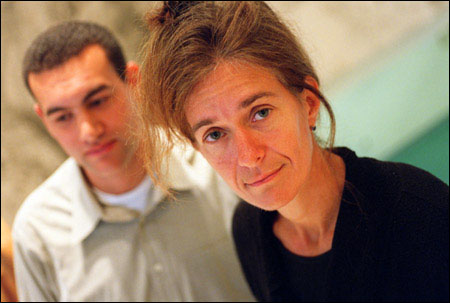Drug-resistant TB strains may spread easily
‘Law of unintended consequences’ could lead to disaster, say HSPH scholars

International efforts to combat tuberculosis may inadvertently be aiding the emergence of deadly, drug-resistant strains of the disease, Harvard School of Public Health researchers found.
Current strategies are based on the assumption that multidrug-resistant strains can safely be ignored because the changes that make them drug-resistant also make them less able to reproduce and spread.
Postdoctoral fellow Ted Cohen and Assistant Professor of Epidemiology Megan Murray say that assumption is in error. Studies have already shown that different types of multidrug-resistant tuberculosis exist and that some spread as easily as nondrug-resistant strains.
Using that information, Cohen and Murray developed a mathematical model that shows that even a small number of resistant strains that are fit from an evolutionary standpoint – meaning they can reproduce and spread well – will gradually make up a larger and larger percentage of tuberculosis cases until they present a major public health problem.
“In the places where there’s a lot of TB transmission, the drug-resistant strains that happen to be fit will be the ones that spread and then become highly prevalent,” Murray said.
Tuberculosis is one of the world’s deadliest diseases, killing roughly 2 million people in 2002, according to the World Health Organization. Though tuberculosis can infect any part of the body, it typically attacks the lungs. The disease is easily transmitted when infected people cough and others inhale airborne particles containing tuberculosis bacteria, Mycobacterium tuberculosis.
Though tuberculosis can be a deadly killer, the human body can combat the disease, walling off the bacteria in tiny capsules until some event triggers the disease’s emergence. Experts believe that as much as a third of the world’s population is infected with tuberculosis, though the vast majority shows no symptoms.
Drug-resistant tuberculosis initially develops when tuberculosis patients don’t complete their TB treatments. That can happen when patients take too low a dose of TB drugs, or when they stop the treatments prematurely. That allows the drugs to kill off the tuberculosis in their bodies that are most sensitive, but leaves the most resistant bacteria alive to reproduce. These patients may then transmit the drug-resistant bacteria to others.
Cohen said he and Murray took a different approach from earlier studies on the subject. Previous models looked at what would happen with one strain each of resistant and nonresistant tuberculosis. Run multiple times with different strains, the models led to the conclusion that only at a very high level of fitness would the drug-resistant TB supplant nonresistant tuberculosis.
Cohen and Murray’s model, whose results were published in the journal Nature Medicine, included several strains of nondrug-resistant TB, with varying degrees of fitness, all at the same time. The model showed that the average fitness of drug-resistant strains increased over time as those most fit spread more rapidly than the others.
Though health officials have known of the emergence of drug-resistant and multidrug-resistant tuberculosis for some time, international tuberculosis programs don’t test for drug resistance and routinely treat tuberculosis as if all cases were sensitive to drugs. Murray said that’s mainly because most cases of tuberculosis are still treatable with tuberculosis drugs. It’s also because the test for drug resistance is expensive and because the treatment, should multidrug-resistant TB be detected, is also costly.
Murray said she and Cohen do not recommend stopping or cutting treatment of nondrug-resistant TB in order to combat multidrug-resistant strains of the disease. But they do hope to add to what is already a vigorous debate over how to treat TB. They make the point that fighting drug resistance is important enough that it should attract new resources.
“The change is happening, but there’s a very vigorous debate in the TB policy community,” Murray said. “It’s going to involve finding new resources globally.




